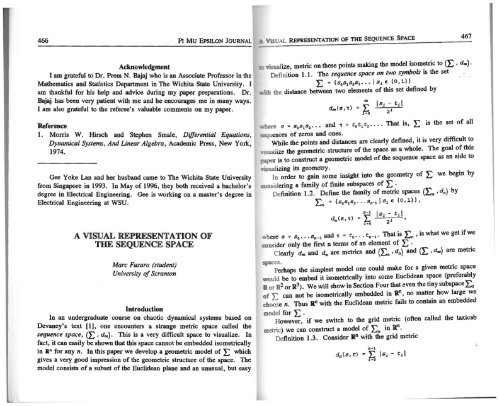Vol. 10 No 6 - Pi Mu Epsilon
Vol. 10 No 6 - Pi Mu Epsilon
Vol. 10 No 6 - Pi Mu Epsilon
- No tags were found...
Create successful ePaper yourself
Turn your PDF publications into a flip-book with our unique Google optimized e-Paper software.
466 PI <strong>Mu</strong> EPSILON JOURNAL<br />
ViSUAL REPRESENTATION OF THE SEQUENCE SPACE<br />
467<br />
Acknowledgment<br />
I am grateful to Dr. Prem N. Bajaj who is an Associate Professor in the<br />
Mathematics and Statistics Department in The Wichita State University. I<br />
am thankful for his help and advice during my paper preparations. Dr.<br />
Bajaj has been very patient with me and he encourages me in many ways.<br />
I am also grateful to the referee's valuable comments on my paper.<br />
Reference<br />
1. Morris W. Hirsch and Stephen Smale, Differential Equations,<br />
Dynamical Systems, And Linear Algebra, Academic Press, New York,<br />
1974.<br />
Gee Yoke Lao and her husband came to The Wichita State University<br />
from Singapore in 1993. In May of 1996, they both received a bachelor's<br />
degree in Electrical Engineering. Gee is working on a master's degree in<br />
Electrical Engineering at WSU.<br />
A VISUAL REPRESENTATION OF<br />
THE SEQUENCE SPACE<br />
Marc Fusaro (student)<br />
University of Scranton<br />
Introduction<br />
In an undergraduate course on chaotic dynamical systems based on<br />
Devaney's text [1], one encounters a strange metric space called the<br />
sequence space, CE , doo). This is a very difficult space to visualize. In<br />
fact, it can easily be shown that this space cannot be embedded isometrically<br />
in Rn for any n. In this paper we develop a geometric model of L which<br />
gives a very good impression of the geometric structure of the space. The<br />
model consists of a subset of the Euclidean plane and an unusual, but easy<br />
visualize, metric on these points making the model isometric to CE . doo).<br />
Definition 1.1. The sequence space on two symbols is the set<br />
L = {s 0 s 1 SzS 3 ••• I s 1 E {011}}<br />
• the distance between two elements of this set defined by<br />
d..,(a ~) = ~ lsi- til<br />
I ~ 2j<br />
a = s 0<br />
s 1<br />
Sz. • • and ~ = t 0 t 1 t 2<br />
• • • • That is, L is the set of all<br />
sequences of zeros and ones. . . .<br />
While the points and distances are clearly defined, 1t IS very dtfficult to<br />
ize the geometric structure of the space as a whole. The goal of this<br />
s-P!r is to construct a geometric model of the sequence space as an aide to<br />
visualizing its geometry.<br />
In order to gain some insight into the geometry of E we begin by<br />
considering a family of finite subspaces of I: .<br />
Definition 1.2. Define the family of metric spaces (En 1 dn) by<br />
En = {s 0<br />
s 1<br />
s 2<br />
••• sn- 1 1 s 1 E {0~1}},<br />
n-1 lsi- tll<br />
dn (a 1 ~) = ~ j )<br />
~ 2<br />
;here a = s 0<br />
• •• sn-l and ~ = t 0<br />
• •• tn_ 1<br />
• That is En , is what we get if we<br />
consider only the first n terms of an element of E .<br />
Clearly doo and dn are metrics and (En 1 dn) and (E 1<br />
doo) are metric<br />
spaces . . .<br />
Perhaps the simplest model one could make for a gtven metnc space<br />
v.'Ould be to embed it isometrically into some Euclidean space (preferably<br />
or R2 or R3). We will show in Section Four that even the tiny subspace Ez<br />
of L can not be isometrically embedded in R 0 , no matter bow large we<br />
dloose n. Thus R 0 with the Euclidean metric fails to contain an embedded<br />
model for L. .<br />
However, if we switch to the grid metric (often called the taxtcab<br />
metric) we can construct a model of En in R".<br />
Definition 1.3. Consider R 0 with the grid metric<br />
:.
















